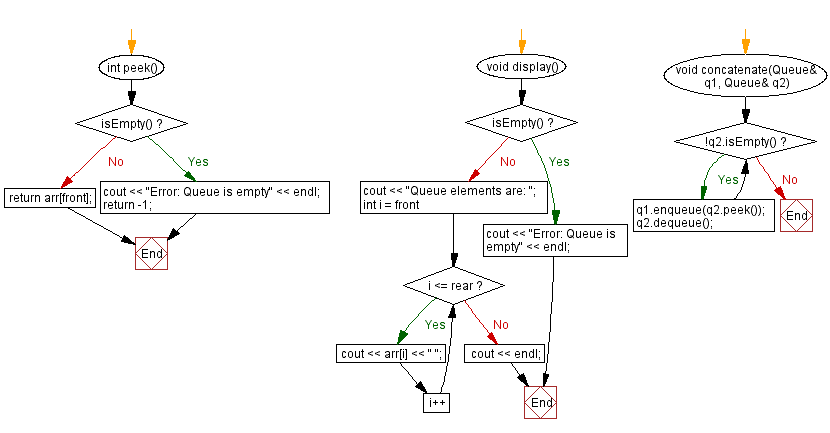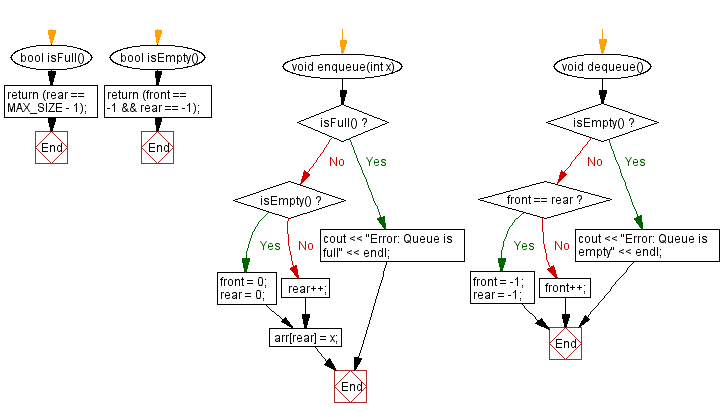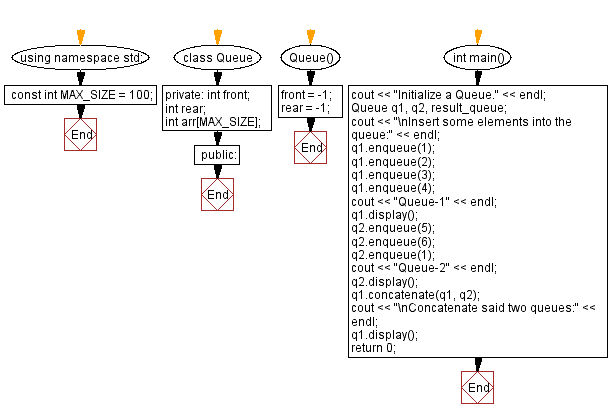C++ Queue Exercises: Concatenate two queues
19. Concatenate Two Queues
Write a C++ program to concatenate two queues.
Sample Solution:
C Code:
#include <iostream> // Including necessary library for input and output operations
using namespace std;
const int MAX_SIZE = 100; // Maximum size for the queue
class Queue {
private:
int front; // Front of the queue
int rear; // Rear of the queue
int arr[MAX_SIZE]; // Array to store queue elements
public:
Queue() {
front = -1; // Initializing front index to -1
rear = -1; // Initializing rear index to -1
}
bool isFull() {
return (rear == MAX_SIZE - 1); // Check if the queue is full
}
bool isEmpty() {
return (front == -1 && rear == -1); // Check if the queue is empty
}
void enqueue(int x) {
if (isFull()) {
cout << "Error: Queue is full" << endl; // Display error if the queue is full
return;
}
if (isEmpty()) {
front = 0;
rear = 0;
}
else {
rear++;
}
arr[rear] = x; // Add an element to the rear of the queue
}
void dequeue() {
if (isEmpty()) {
cout << "Error: Queue is empty" << endl; // Display error if the queue is empty
return;
}
if (front == rear) {
front = -1;
rear = -1;
}
else {
front++;
}
}
int peek() {
if (isEmpty()) {
cout << "Error: Queue is empty" << endl; // Display error if the queue is empty
return -1;
}
return arr[front]; // Return the element at the front of the queue
}
void display() {
if (isEmpty()) {
cout << "Error: Queue is empty" << endl; // Display error if the queue is empty
return;
}
cout << "Queue elements are: ";
for (int i = front; i <= rear; i++) {
cout << arr[i] << " "; // Display all elements in the queue
}
cout << endl;
}
// Function to concatenate two queues
void concatenate(Queue& q1, Queue& q2) {
while (!q2.isEmpty()) {
q1.enqueue(q2.peek()); // Enqueue elements from q2 into q1
q2.dequeue(); // Dequeue elements from q2
}
}
};
int main() {
cout << "Initialize a Queue." << endl;
Queue q1, q2, result_queue;
cout << "\nInsert some elements into the queue:" << endl;
q1.enqueue(1);
q1.enqueue(2);
q1.enqueue(3);
q1.enqueue(4);
cout << "Queue-1" << endl;
q1.display(); // Display elements of queue 1
q2.enqueue(5);
q2.enqueue(6);
q2.enqueue(1);
cout << "Queue-2" << endl;
q2.display(); // Display elements of queue 2
q1.concatenate(q1, q2); // Concatenate queue 1 and queue 2
cout << "\nConcatenate said two queues:" << endl;
q1.display(); // Display concatenated queue
return 0;
}
Sample Output:
Initialize a Queue. Insert some elements into the queue: Queue-1 Queue elements are: 1 2 3 4 Queue-2 Queue elements are: 5 6 1 Concatenate said two queues: Queue elements are: 1 2 3 4 5 6 1
Flowchart:



For more Practice: Solve these Related Problems:
- Write a C++ program to merge two queues into a single queue while preserving the original order of both.
- Write a C++ program to concatenate two queues and then remove any duplicates from the resulting queue.
- Write a C++ program to join two queues element-wise and alternate their elements into a new queue.
- Write a C++ program that concatenates two queues and then sorts the merged queue in ascending order.
Go to:
PREV : Remove All Elements Greater Than a Number from a Queue.
NEXT : Copy One Queue to Another.
CPP Code Editor:
Contribute your code and comments through Disqus.
What is the difficulty level of this exercise?
